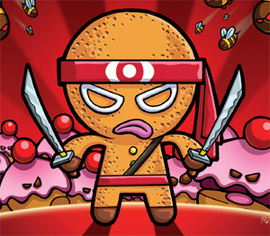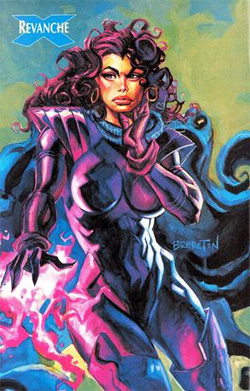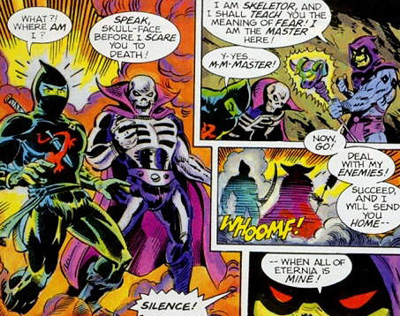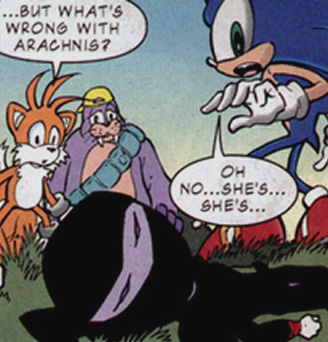The 10 Lamest Fictional Ninja
 |
By Todd Ciolek
The pop-culture ninja is a curious creation, born of Hollywood romanticizing what was probably an unpleasant and crude art of assassination and stealth from feudal Japan. Rejecting historical accuracy, the ninja is a staple of cartoons, movies, video games, comics, and television for a very simple reason: to the young and impressionable viewer, the simple concept of a ninja is innately cool.
Yet sometimes a ninja doesn’t work. Often it’s the result of someone assuming that a simple, black-clad thug is good enough, and at other times it comes from someone trying too hard to crossbreed the basic ninja with some other clich?. Instead of carping about intentional comedies like Beverly Hills Ninja, we’re focusing this list on the characters that were supposed to dig into the ninja-loving centers of our reptilian childhood brains. For one reason or another, they didn’t.
10) Nightbird, Transformers
We feel bad picking on the robotic female ninja Nightbird, as the ’80s Transformers cartoon was so lacking in female characters that Nightbird’s mere presence was a move toward equality. Yet this robo-ninja is handled oddly. She’s presented as the amazing (why?) new creation of a Japanese scientist, and she’s soon stolen by Megatron, Starscream, and the other Decepticon stooges, whose plans for world domination were losing some ambition at this point in the show. Under Megatron’s control, Nightbird becomes a lethal stealth machine that sneaks into Autobot headquarters and beats the robot crap out of some second-string Transformers. Then Starscream, blatantly jealous of Megatron’s affection for Nightbird, blasts the robot ninja and wraps up the episode.
In a sense, “Enter the Nightbird” feels like a strange piece of fan fiction. Nightbird doesn’t say anything and does little beyond basic cartoon ninja stuff, but all of the Autobots and Decepticons can’t stop talking her up, like she’s the author’s very own Mary Sue. At best, her appearance makes for an odd episode that does little beyond exploring the emotions that underscore Megatron and Starscream’s contentious relationship. That, we’re sure, has inspired too much fan fiction of its own.
9) Revanche, X-Men Comics
Among superhero comics, few villain archetypes are older and less imaginative than an evil version of a main character. The likes of Bizarro Superman and Reverse Flash are relics of a bygone era in comics, and it took slavering fangs and an alien origin to make kids accept Venom as more than a black-suited version of Spider-Man. It’s an especially weak idea when it’s used on less prominent super-types, like Psylocke of the X-Men. For those not up on their preposterous superhero origins, Psylocke was originally a British telepath named Betsy Braddock, but then her mind got switched with that of a Japanese assassin named Kwannon. So Betsy became Psylocke, a ninja with amazing psychic abilities and a sleekly revealing outfit. She also has a good number of fans, despite the fact that no X-Men writer really seems to know what to make of her. A stupid backstory will do that. 
Anyway, the mind transfer that created Psylocke also resulted in Kwannon being stuck in Betsy’s British body. While this might have resulted in some strange new study of just how much of one’s self is retained in one’s physical form, it just made Kwannon call herself Revanche and gave her pretty much the same powers as Psylocke: telepathy, sharp reflexes, and the ability to create a glowing psionic blade. Oh wait. Instead of a psi-dagger like Psylocke has, Revanche got a big purple katana. Evil Psylocke and Good Psylocke’s rivalry was largely derailed by Revanche’s failure to do much of anything. She then died during the outbreak of the Legacy Virus, a pandemic highly contagious among unwanted supporting X-Men characters. Psylocke died at least once, too, but then she came back. And possibly so did Revanche. And then we stopped reading superhero comics forever.
8) Ninjor, Masters of the Universe
Ninja showed up in kids’ shows throughout the 1980s, much to the consternation of British censors, but it wasn’t until 1987 that the ninja wave really rose, with a little cartoon called Teenage Mutant Ninja Turtles. They soon overshadowed other attempts, but He-Man and The Masters of the Universe stabbed at a piece of the ninja pie that same year with a bold new character: Ninjor! 
Okay, so Ninjor isn’t that stupid of a name in the Masters of the Universe canon, where any profession or verb can be turned into a toy with the suffix “-or.” Ninjor’s real failing is that, for all his ancient and lethal martial arts, he’s just another goon for He-Man to knock around. Since Masters of the Universe had wrapped up its TV syndication deal by 1987, Ninjor had to debut in the comic book. In a catch-all issue that crams in as many new characters as possible, Ninjor is one of two new flunkies that Skeletor summons from other worlds.
Come on, Ninjor. You’re an assassin, and all you can do is act confused and then kiss the ass of the first guy who bosses you around in this new dimension. At least Scare-Glow, the talking Halloween decoration, got off a decent threat before being drafted into Skeletor’s pushover army. Even Ninjor’s toy is disappointing; despite some attempts to evoke the air of ancient Japanese warrior, Ninjor has pointy monster feet and the same furry underwear that just about every non-female, non-robot He-Man figure wears. As a late release in the Masters of the Universe line, Ninjor commanded high prices among collectors, but being expensive doesn’t make you a good ninja.
7) Surf Ninjas
Surf Ninjas is hated by critics and loved by a minor following of possibly ironic fans. The fans may have a point, since Surf Ninjas is just about the only film where you’ll see Leslie Nielsen strut around in the regalia of a Star Trek Borg (a fact that surprises us considering the sort of films Nielsen’s lent himself to over the past twenty years). Other highlights of Surf Ninjas: Rob Schneider in a rare half-amusing role, some pretty Thailand scenery, and the most awkward, intrusive Sega product placement ever.
That said, it’s a painfully early-’90s piece of hokum, with quips and sight gags that play out like Raiders of the Lost Ark and Enter the Dragon run through a Saved by the Bell filter. Then there’s the Sega Game Gear in its first and only starring role, which makes Nintendo’s game-shilling The Wizard seem remarkably subtle. The Wizard played up Super Mario Bros. 3 as a religious, life-changing experience, but at least it didn’t promise kids that their Game Gears could control real life. The system couldn’t even get you all of the way through the lousy Surf Ninjas tie-in game without needing new batteries.
6) Super Ninja, Chuck Norris and the Karate Commandos
Chuck Norris found his most enduring TV success with Walker, Texas Ranger, but that staggering achievement shouldn’t overshadow his Karate Commandos mini-series. In this five-episode serial crapped out by Ruby-Spears in 1985, Chuck heads a team of crime-fighters that include a sumo wrestler who’s always hungry and a kid who fills the insufferable, overeager role that every kid character filled to varying degrees in cartoons from 1979 to 1991. A cartoon is only as good as its villains, of course, and Karate Commandos pitted Norris and his brigade of stereotypes against a villain cal
led The Claw (not Dr. Claw, mind you) and his chief minion…Super Ninja.
Yes, that’s it: Super Ninja. He dresses like a short-lived pro-wrestling gimmick from the 1980s, complete with yellow briefs and a face mask that suggests a luchador more than a slithering assassin. Still, he may rank as the only ninja to sneak a parachuting alligator onto a tightly guarded military base.
5) Uma Arachnis, Sonic the Hedgehog Comics
Like a lot of the animal-people characters created for today’s Sonic the Hedgehog comics, Uma Arachnis and her story symbolize everything that’s gone wrong with the hedgehog who once rebuilt Sega. Here’s her deal: Uma is a ninja spider and partner of a villain named Kodos (not the alien from The Simpsons), and they get shuffled around various parts of the disturbingly large Sonic universe. Upon realizing that Kodos doesn’t have her best interests in mind, Uma swipes his treasured Sword of Acorns (seriously) and sorta ends up a good guy for a little while.
Sounds conventional and not particularly insane, doesn’t it? Well, as Sonic comics continue, Uma dies when she’s weakened by radiation and attacked by her former partner. And because nearly everyone in Sonic comics is a cutesy woodland animal straight out of Sega’s marketing department, Uma’s tragic fate is played like an episode of The Shirt Tales about gangland slayings. Remember when Sonic just ran fast and ate chili dogs? Screw that. It’s all radiation sickness and death involving characters who look like they stepped out of Silly Symphonies shorts.
4) Ninja Breadman
There’s something particularly fascinating about the surfeit of terrible games dumped on the Wii and PlayStation 2 in recent years. Every popular game system (and the occasional unpopular one) gets deluged with cheap, boring titles programmed absentmindedly in a few months’ time, but the worst of the Wii and the PlayStation 2 are special, offering such delights as Escape from Bug Island, an Alvin and the Chipmunks music game, and the entire Phoenix Games catalog of Disney rip-offs. And somewhere near that barrel’s bottom, there’s Ninjabread Man.
Ninjabread Man. Because it sounds a little like Gingerbread Man. He’s a cookie ninja with a headband, a sword, and a face of grimly frowning icing. Like many of the worst ninja, he’s terrible primarily because he’s so boring, with not even voice samples to break up the monotony of his game. It doesn’t help that he’s also a complete pushover.
3) Unnamed Ninja Robot, Ninja Terminator
Director Godfrey Ho is considered a treasure among fans of terrible Hong Kong martial-arts cinema. An economic storyteller above all else, he pieced together ’80s movies from clips just as a mosaic artist would build a work of modern art. He also used whatever he could find when it came to special effects. Thus, his depictions of ninja are often a bit on the low-budget side.
The most memorable might be an imposing ninja-robot messenger that delivers a stern warning to Richard Harrison, the star of the 1985 Godfrey Ho classic Ninja Terminator. A flashing terror, it stumbles forward a few inches while booming out its ultimatum, prompting a follow-up threat via Garfield phone. Transformers fans will note that the robot is, in fact, a re-colored bootleg Omega Supreme that’s missing its hands.
2) 3 Ninjas
It’s not clear who’s to blame for the 3 Ninjas film franchise, aside from the various names in the credits. But really, it’s only their fault that they made the first 3 Ninjas movie. Someone else is responsible for making the unnecessary sequels — including 3 Ninjas Kick Back, 3 Ninjas Knuckle Up, and 3 Ninjas: High Noon at Mega Mountain — to the point where one of them co-starred Loni Anderson and a marginally recognizable Hulk Hogan.
We blame the school of film that started with Home Alone and convinced producers everywhere that family movies needed children getting the better of apparently brain-dead adults. That’s the premise of the first 3 Ninjas, in which three pre-teen brothers learn martial arts from their grandfather, receive ninja names like “Colt” and “Tum Tum,” and then help the FBI break up a smuggling ring. It’s clearly inspired by The Goonies and The Karate Kid, or more specifically just the VHS box write-ups for those films. Had the producers actually watched them, they’d have put together something more appealing.
1) The Live-Action Teenage Mutant Ninja Turtles
The Teenage Mutant Ninja Turtles come in several varieties, most of them entertaining. The original black-and-white comic Turtles are violent little pulp fantasies, the ’80s cartoon Turtles are amusing for their era, and the most recent Turtles animated series wasn’t a bad compromise between the comic and the cartoon. The worst part of Turtle canon, aside from that frustrating old NES game, lies in the attempts at live-action adventures. At their worst, they were parades of big rubbery turtle costumes and general embarrassment for all concerned.
We’ll concede that the first live-action Teenage Mutant Ninja Turtles movie isn’t horrible. The second, however, is a relentless slouch toward crap, with an even sharper decline once Vanilla Ice takes the stage to deliver his chart-topping “Ninja Rap.” And then it’s on to the next bloated latex nightmare of a Ninja Turtles movie, which involves time travel and ancient Japan, but no Vanilla Ice
(who was, at this point, too busy evading mobs armed with tar and feathers). Then there were live shows full of grown adults in suits running around on stage before whatever children weren’t yet sick and tired of Ninja Turtles. However, the whole idea of live-action Turtles incontestably reached its lowest point with a 1994 Christmas special.
Yes, that’s the Teenage Mutant Ninja Turtles rapping about the joys of skillfully wrapping Christmas presents. Other highlights of this feature include the death of all that’s good and tasteful in this world.
